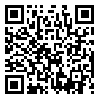Volume 21, Issue 4 (2021)
MCEJ 2021, 21(4): 185-203 |
Back to browse issues page
Download citation:
BibTeX | RIS | EndNote | Medlars | ProCite | Reference Manager | RefWorks
Send citation to:



BibTeX | RIS | EndNote | Medlars | ProCite | Reference Manager | RefWorks
Send citation to:
maleki A, sattari A, Lotfollahi Yaghin M A. Improved Cyclic Behaviour of Concrete Filled Tube (CFT) Using Rotational Friction dampers and bracing. MCEJ 2021; 21 (4) :185-203
URL: http://mcej.modares.ac.ir/article-16-44188-en.html
URL: http://mcej.modares.ac.ir/article-16-44188-en.html
1- Faculty of islamic Azad University Maragheh Branch , a.maleki@iau-maragheh.ac.ir
2- PhD student
3- Professor of Civil Engineering, University of Tabriz
2- PhD student
3- Professor of Civil Engineering, University of Tabriz
Abstract: (3253 Views)
AbstractRotational friction dampers are a specific type of friction dampers which have several advantages. Dampers are used to improve the cyclic behavior of structures against forces caused by wind and earthquake. These types of dampers will cause energy dissipation by its rotating and rerotating. However, complete and comprehensive researches have not been performed on the effect of rotational friction dampers and their effect on the bearing capacity of steel frames. In this research, the behavior of concrete-filled steel tube (CFT) in two cases frame braced with rotational friction dampers and frame braced without rotational friction dampers is investigated. For verification, the results obtained from finite element method software, ABAQUS, were compared with that of experimental studies for test samples used in a building with a height of 300m in Osaka, Japan. The hysteresis curves of the modeled samples are in good agreement with the experimental results.
In order to investigate the performance of steel composite frame (with CFTs) braced with rotational friction dampers towards to steel composite frame (with CFTs) braced without rotational friction dampers under the effect of three earthquake Far-field records, the structure was modeled, designed and analyzed in ETABS software. The use of bracing with rotational friction dampers has caused a decrease in the displacement of the roof’s center of mass for each record mentioned above which modeled in ETABS software. It decreased by 13 to 49 % for 9 records and increased by 2 to 17 % for 2 records. The use of bracing along with rotational friction damper modeled in ABAQUS software under the effect of each record has caused a decrease in base shear. The extent of these reductions was different for each record mentioned above. In each record modeled in ETABS software, the base shear of the structure has not reduced similarly; however, in some cases, the base shear has increased. It had a decrease of 11 to 37% for 7 records and an increase of 3 to 26% for 4 records.Then a Single-storey frame with single-span With the same materials and specifications introduced in ETABS software in ABAQUS software Has been modeled. For lateral loading of columns, the lateral loading protocol based on ATC-24 and the instructions for using dampers in the design and reinforcement of buildings have been used.
According to Regulation No. 766 of the Program and Budget Organization, the loading cycles introduced in ETABS software with a frequency of 1.15T have been used in the ABAQUS Limited Components Software to move. The use of rotary braces and crankshafts in the ABAQUS limited component software under the influence of each of the discussed records has reduced the displacement of the structure relative to the structure without braces and without rotational friction dampers of the structure mentioned above was exerted under the record effect of the same earthquake in ABAQUS software The use of bracing along with rotational friction damper modeled in ABAQUS software under the effect of each record has caused a decrease in base shear. The amount of energy reduction for records understudy was not equal and varied from 8% to 34.7%. The hysteresis curves of base shear of braced structures with and without dampers are well presented.
Keywords: Composite steel bending frames, Energy damping, Circular damping, Hysteresis curve, Stiffness
Article Type: Original Research |
Subject:
Earthquake
Received: 2020/07/5 | Accepted: 2021/03/17 | Published: 2021/08/1
Received: 2020/07/5 | Accepted: 2021/03/17 | Published: 2021/08/1
Send email to the article author
| Rights and permissions | |
 |
This work is licensed under a Creative Commons Attribution-NonCommercial 4.0 International License. |







